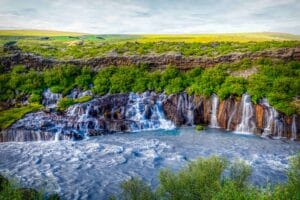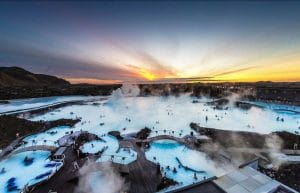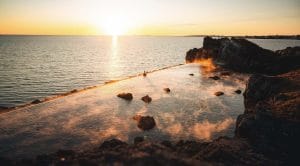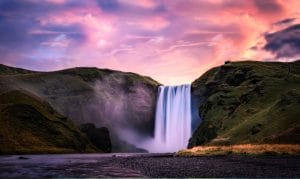One of the most beautiful black lava pearl beaches in Iceland. This is an arched-shaped bay with mysterious rocks, intense black sand, marvelous coast rocks, and black pebbles too! But yes! Not to forget about the intensely strong and human-sized waves that never miss hitting the shore with complete power that engulfs everything on its way. While passing Snæfellsnes peninsula, Djúpalónssandur is one such place that you cannot afford to miss. It is located on the foot of Snæfellsnes Peninsula in Western Iceland. The geological uniqueness of this place is commendable and is something that you would have never imagined. Djúpalónssandur is more than just a beach!

Djúpalónssandur: A Majestic Black Pebble Beach
Djúpalónssandur is a beautiful black-sand beach located on the Snæfellsnes Peninsula in western Iceland. The beach is situated on the coast and is known for its unique geological formation and its proximity to other natural attractions.
Djúpalónssandur is a black-sand beach that is formed by volcanic activity in the area. The black color of the sand is due to the presence of volcanic rocks and minerals such as basalt and lave. The beach is surrounded by a rugged and dramatic landscape, with rocky cliffs and lush green vegetation.
Visitors can hike to the beach and enjoy the beautiful views of the beach and the surrounding landscapes. The hike is considered easy and takes about 20 minutes to complete. It’s well-maintained and suitable for visitors of all ages and fitness levels. The trail offers great views of the ocean and the nearby cliffs.

Immense Respect for Nature
Iceland is known for the immensely beautiful and dramatic landscape with lava fields, volcanoes, hot springs, geyser, and massive cliffs and glaciers, which are protected in the Snæfellsjökull and Vatnajökull National Parks. These have been preserved over the years and not been harmed by the people. Respect for nature is deeply engraved in the minds of natives and that can be seen when you visit those beautiful locations of Iceland. Djúpalónssandur is one such place with interesting lava rock formations, coast cliffs, black sand, and rocks. But it is always suggested to the visitors and natives not to climb the rocks, harm the natural formations, or even take away the pebbles from the beach since this can severely influence the natural landscape.
The Lifting Stones
In Djúpalónssandur you can find the famous lifting stones. The stones were used as a test of strength for prospective sailors. The stones are named based on the weight of the stone and the strength required to lift it. The stones are:
- Holtasteinn (The Easy Stone) – This stone weighs 23-33 kg (50-73 lbs) and was used as the first test for sailors. It was considered the easiest stone to lift and was used to test the strength of young sailors.
- Grýlukollur (The Grýlu Stone) – This stone weighs 33-43 kg (73-95 lbs) and was considered a moderate challenge for sailors. It was used to test the strength of more experienced sailors.
- Bjarnastein (The Bear Stone) – This stone weighs 43-53 kg (95-117 lbs) and was considered a difficult test for sailors. It was used to test the strength of the strongest sailors.
- Amlóði (The Useless Stone) – This stone weighs over 53 kg (117 lbs) and is considered impossible to lift. It is said that only one sailor was able to lift it.
These four stones were used as a traditional test of strength for sailors who were seeking employment in the fishing industry. It was believed that sailors who could lift the heaviest stones were the strongest and best suited for the physically demanding job of fishing. Nowadays, visitors to the beach can test their own strength and see how they measure up against these historic lifting stones.

Djúpalónssandur Lagoons
Djúpalónssandur beach is also known for its lagoons, which are formed by the tide coming in and out of the bay. There are two main lagoons at Djúpalónssandur, the first one is called Djúpulón and the second is called Djúpudalslón. Both lagoons are connected to the sea and are surrounded by the beautiful and rugged landscapes of the Westfjords region of Iceland.
Djúpulón is the larger of the two lagoons and is located near the beach. It is a shallow lagoon with crystal clear water, which makes it perfect for swimming and snorkeling. The lagoon is surrounded by black pebbles and offers a great spot to relax and soak in the natural beauty of the area.
Djúpudalslón is the smaller of the two lagoons and is located further inland. It is a deeper lagoon surrounded by steep cliffs, and is not accessible by foot. The lagoon is known for its beautiful and serene setting, and is a popular spot for bird-watching, as it is home to a variety of sea birds.
Both lagoons are a popular spot for visitors to Djúpalónssandur, as they offer a unique opportunity to experience the natural beauty of Iceland. Visitors can explore the lagoons on foot, by swimming, or by taking a boat tour. Many visitors also enjoy taking a dip in the clear, cool waters of the lagoons as well as enjoying the beautiful surroundings.
How to Get There?
Drive to Útnesvegur road on Snæfellsnes Peninsula nr. 574, when going to Djúpalónssandur. Turn to the south when you reach intersection nr. 572 – Dritvíkkurvegur road. You can see the parking lot by Djúpalónssandur cove.
Map of Djúpalónssandur
Interesting locations in the area
Locations
- Vatnshellir Lava Cave
- Lóndrangar
- Malarrif Lighthouse
- Rauðfeldsgjá
- Arnarstapi
- Snæfellsjökull
Activities
- Snæfellsnes Horse Riding
- Snæfellsjokull glacier hike
- Vatnshellir Lava Cave
- Puffin Tour
- Whale Watching
Hotels & Restaurants
- Hotel Búðir
- Fosshotel Hellnar
- Kirkjufell Hotel
- Bjargsteinn Mathús
- Sjávarpakkhúsið













































